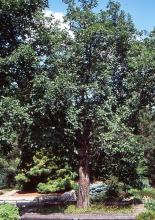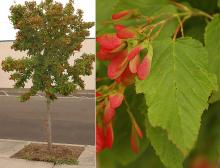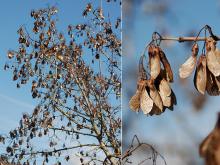Acer tataricum
Common name:
Tatarian Maple
Tartarian Maple
Pronunciation:
A-ser ta-TAR-i-kum
Family:
Sapindaceae, Aceraceae
Genus:
Type:
Broadleaf
Native to (or naturalized in) Oregon:
No
- Broadleaf deciduous shrub/tree, 15-20(30) ft [4,5-6(9) m] high, similar width, often multistemmed, rounded to wide spreading. Leaves opposite, simple, 5-10 cm long, usually unlobed (leaves on young trees may be 2-5 lobed), margin double serrate, medium green, in fall yellow, red to reddish brown; petiole 2-5 cm long. Flowers greenish white, in upright, long stalked clusters (panicles). Fruit (samaras) 2-2.5 cm long, wings nearly parallel.
- Sun to part shade, adaptable, tolerant of drought, performs best in well-drained soil. Possibly more tolerant of alkaline soils than Acer ginnala (Dirr, 1998). Upright-growing cultivars may be a better choice as street trees because seedlings of the species are variable (Dirr and Warren, 2019).
- Hardy to USDA Zone 3 Native to southeastern Europe and western Asia.
- Taxonomy: The World Flora Online (WFO) considers Acer ginnala to be a subspecies of Acer tataricum, hence Acer tataricum subsp. ginnala. Although the leaves of adult Acer tataricum trees are unlobed, those of young trees or vigorous shoots may be 3- to 5-lobed, resembling those of Acer ginnala.
- tataricum: of central Asia, formerly Tartary. It is a historical region located in northern and central Asia stretching eastwards from the Caspian Sea and from the Ural Mountains to the Pacific Ocean, inhabited mostly by Turkic peoples.
- Corvallis: west side of First Street (River Front), between Tyler and Van Buren.







